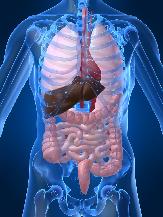Recommended Products
"You are what you assimulate from what you eat."
 The digestive system breaks down the food we eat, extracting nutrients and assimilating them for use throughout the body. Proper digestive system function is essential to maintaining good health and energy levels. The body requires nutrients from all three food categories (proteins, carbohydrates and fats) to survive. The digestive system breaks down the food we eat, extracting nutrients and assimilating them for use throughout the body. Proper digestive system function is essential to maintaining good health and energy levels. The body requires nutrients from all three food categories (proteins, carbohydrates and fats) to survive.
Digestive concerns are common to Americans. These include indigestion, heartburn, acid reflux, insufficient enzymes, stomach ulcers and stomach cramps.
EXAMINING THE DIGESTIVE SYSTEM
After food is chewed and swallowed, it passes through the esophagus and enters the stomach. The stomach secretes hydrochloric acid and certain enzymes to begin the breakdown and sterilization of the food. The stomach is particularly important to the digestion of proteins. Typically, the stomach will hold about a quart of food or liquid, but its muscular walls can expand to hold much more than this.
The stomach is lined with a durable mucous coating that protects it from hydrochloric acid and other gastric juices. Ulcers form when a portion of this mucous lining wears thin, and the digestive juices aggavate the stomach.
The bulk of nutrient assimilation takes place in th small intestine. The circulatory system carries nutrients from the small intestine to the cells of the body. The small intestine is lined with tiny fingerlike projections called villi and tinier cytoplasmic projections called microvilli. These villi increase the surface area of the intestine and allow for more efficient nutrient absorption. The average adult's small intestine is 10-13 feet long, and about one inch in diameter. Because of the villi and microvilli, the total surface area of the small intestine is about 180 square meters -- just smaller than a tennis court.
The first 10 inches of the small intestine is known as the duodenum; it is the most important section in digestion. Here, enzyme secretions from the pancrease and bile secretions from the liver mix with the food and break down carbohydrates, proteins and fats into smaller units. The body can assimilate these nutrients in smaller forms and use them for energy. The duodenum also secretes lactase to digest milk products, and sucrase and maltase to break down sugars.
The next sections of the small intestine are the jejunum and the ileum. In this combined 9-12 foot segment, and additional 2-3 liters of intestinal juioes are secreted each day. Because food particles have to be a certain size before they can be absorbed into the bloodstream, digestion and assimilation in this section can take several hours. The villi and microvilli absorb tiny nutrients that travel through the lymph vessels or into capillaries for transport to the liver. After the liver filters and processes these nutrients, the are sent throughout the body.
The pancreas is an important part of the digestive process, producing approximately three pints of digestive juices each day. These juices pass through the pancreatic duct into the small intestine. This organ also controls the amount of sugar in the blood by secreting two hormones, glucagon and insulin. Insulin and glucagon work as a check-and-balance system, regulating the body's blood sugar level.
The liver is also critical to digestion. It is located in the right side of the upper abdomen, under the diaphragm. This is the largest internal organ in the body, weighing about 3-4 pounds. The liver is composed of groups of cells called lobules. Anywhere from 50,000-100,000 lobules make up the liver, and each lobules has a central vein that drains blood into the hepatic veins, which eventually carry it to the heart. The liver produces bile, which breaks down, or emulsifies, fats. Bile drains from the liver lobules into the branches of the bile ducts that lead to the gallbladder, where it is stored.
All told, the liver performs more than 500 functions, many of them of a processing or storage nature. The liver processes potential poisons for removal from the body, including alcohol and drugs. It also breaks down old red blood cells and reprocesses body substances, extracting iron from hemoglobin, and reusing amino acids.
The liver stores carbohydrates as glycogen, which can be quickly converted into glucose (for energy) if needed by the brain, muscles, or other organs. It also stores certain nutrients like vitamins (A, B-complex, B12, D, E and K), releasing them into the blood when the body needs them. These reserves can last several months. The proteins albume, globulin and fibrinogen --all the components of blood plasma-- are also manufactured in the liver.
Did You Know?
♦ 60-70 million Americans suffer from digestive disease (National Digestive Disease Information Clearinghouse)
♦ Americans spend $107 billion on drugs and antacids to fight digestive ailments in 1992.
♦ 70-year-olds may produce as little as half the enzymes they produced when they were 20.
♦ By age 50, many people will produce only12 percent of the hydrochloric acid they produced at age 25. About one-third of all people over the age of 65 secrete almost no hydrochloric acid!
♦ Silymarin, a mixture of bioflavonoids found in the plant milk thistle, helps protect the liver. Clinical studies show that silymarin has antitoxic properties and is effective in preventing liver damage.
|